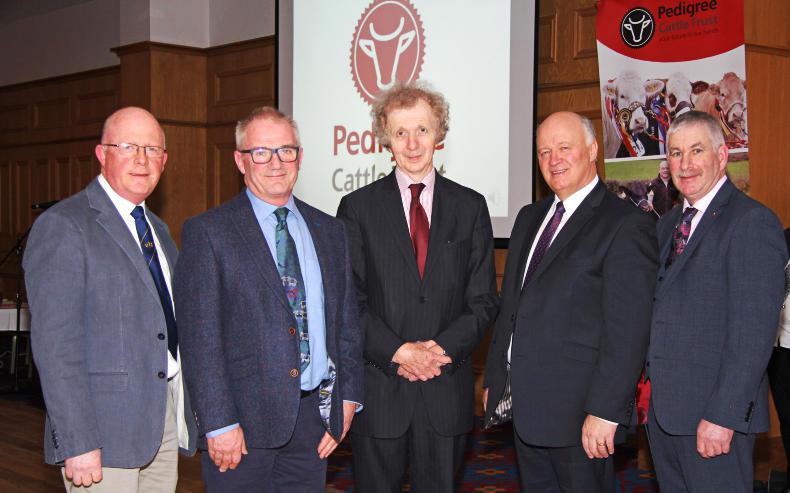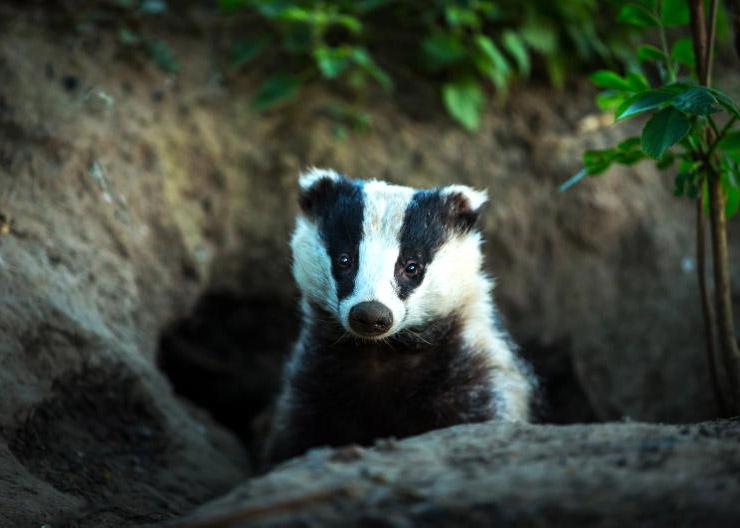The newly formed Pedigree Cattle Trust held its first seminar in Portadown last week.
Set up to represent the interests of NI pedigree cattle breeders, particularly around the issue of bovine TB, the trust has brought together pedigree beef and dairy breeders, under the chairmanship of Portadown solicitor Brian Walker.
The event last week focused on new developments in TB testing, with speakers including DAERA vet Fraser Menzies, UFU deputy president Victor Chestnutt, Devon vet Dick Sibley and Upper Bann MP David Simpson.
While much of the content highlighted the many complexities around TB, the subsequent debate inevitably centred on DAERA plans to make farmers pay for one herd test per year and cap compensation for reactor animals (£1,800 for pedigree animals; £1,500 for non-pedigree; paid to 75% of market value by year two of the new policy). A DAERA consultation on future TB policy in NI closes on Monday 5 February.
During his presentation, Victor Chestnutt set out the thinking in the UFU, which has floated the idea of a levy on all cattle farmers rather than cutting compensation or charging for testing. The proposed levy would be around £1 per head, but to a maximum of £3 per head, which if implemented, would realise approximately £4.8m per annum. This money would not be handed directly to DAERA, instead to an industry-led body, such as Animal Health and Welfare NI, who would then employ pest control contractors to undertake wildlife intervention work, to include a cull of badgers in TB hotspot areas.
With TB in NI currently costing taxpayers upwards of £40m, Chestnutt argued that farmers can’t continually say “no” to any attempts to cut costs, or find new funding options. “If we say no, no, no, we will just get everything in the DAERA proposals imposed on us,” said Chestnutt.
However, his argument did not meet with universal approval from his audience.
Summing up the position of the Pedigree Cattle Trust, Brian Walker said that the farming industry should only be asked to fund TB measures once DAERA can prove that it is making significant progress towards eradicating the disease in NI.
“As a body, we do not understand why the Republic of Ireland can reduce the disease problem while NI continues to have an increased incidence due to a refusal from Government to adopt the same policy as its counterpart in Ireland. Farmers should not be asked to fund failure,” concluded Walker.
Burden of TB on larger farms
Speaking to the Irish Farmers Journal, Holstein NI breeder and Waringston dairy farmer Charlie Weir questioned whether the UFU proposal for a levy on all cattle was fair to larger farmers.
“Why should larger farmers effectively be asked to pay more? Why should I pay out thousands, yet a neighbour with a small herd might only have to pay a nominal amount, so has little incentive to keep TB out of their herd? Unless that incentive is there for everyone, it won’t work,” Weir said after the meeting.
Instead, he suggested that the levy rate per head could be linked to other measures. For example, a farm that puts in place good biosecurity might have to pay less per head.
Farmers not profiting from TB
The DAERA consultation on a future TB eradication policy closes next Monday, and is expected to receive responses from across the rural community.
According to Kilkeel farmer Oisin Murnion, there is a perception among some environmentalists that the estimated £40m taxpayer bill for TB ends up in the pockets of farmers.
In fact, it is expected that the total amount going for TB reactor compensation will be around £24m in 2017/2018, with the remainder going on DAERA veterinary costs and on testing by private vets.
“Some people seem to think that farmers are ripping the whole thing off. They just don’t realise that testing costs farmers money, and being locked in with TB can lead to serious financial hardship. The DAERA focus on cutting compensation for TB reactors has sent out the wrong message,” he said.
Devon vet advocates new approach
Keynote speaker at the Pedigree Trust seminar was Devon vet Dick Sibley, a director of West Ridge Veterinary Practice, which operates in the TB-hotspot area of southwest England.
He outlined his experience working with Gatcombe Farm, a 300-cow dairy herd in Devon, that has been chronically infected with TB for a number of years.
It is these types of herds that Sibley believes are the greatest threat to TB control. When a large herd is currently clear of the disease, he said he was “bewildered” that more isn’t done to make sure they stay free of the disease. “Once it is established in a large dairy herd it is very hard to get out. You can shoot as many badgers as you like, but as long as you have these chronic herds, you are wasting your time,” said Sibley.
In the case of Gatcombe farm, it has been under TB restriction for over 10 years, and continually finding one or two reactors at a test. While the conventional skin test is generally recognised as being good at picking up animals that have TB (few false positives), not all animals with TB react to the test. That prompted Sibley to look at other options, including a Phage test developed by Nottingham University, which detects live TB bacteria in milk or blood, or a PCR test, developed by Warwick University, which detects TB in faeces.
The work is expensive, but it has helped to identify cows in the Gatcombe Herd that were shedding TB in faeces, but otherwise clear at a skin test. “The herd is still not clear. It will be a four- to five-year slog to clear it completely. But we have got to take ownership of the disease. We want every tool in the box – there is no right or wrong way,” he insisted.
He also has prominent badger campaigner Brian May on board, with his “Save Me Trust” committing to paying for a four-year badger vaccination programme in the area surrounding the farm, at a cost estimated at £450 per vaccinated badger.
Slurry
As well as trying to identify all animals with TB, Sibley outlined other actions being undertaken at Gatcombe, including stopping spreading slurry on grazing land on the farm, which he believes is a risk factor in spreading the disease to other cattle, and also badgers.
Immunity
While Gatcombe Farm has not seen big numbers of animals go down at one test, Sibley has experience of this on other farms in Devon. He believes that it can be linked to separate disease issues such as BVD or IBR, which supresses immunity, putting more cattle at risk.
Test
On the current skin-testing regime approved in Europe, Sibley asked why it was necessary to test in the neck area, when others, for safety reasons, are now using the fold under the base of the tail. Similarly, why include a top lump (mycobacterium avium), when using just the bottom lump (mycobacterium bovis) would help to improve the sensitivity of the skin test?
“I just don’t get that. It is a joke. New Zealand and Australia have abandoned the top lump,” said Sibley.
However, if that policy was adopted in NI it would significantly increase the number of TB reactors, and would invariably come at a high cost to taxpayers.
DAERA vet defends skin test
When asked for his opinion on the ideas presented by Dick Sibley, DAERA vet Fraser Menzies said that he agreed with a lot of what had been put forward, but would like to see any new tests blind trialled and fully validated before making a final judgment.
In his presentation, Menzies defended the current skin test, pointing out that just because a reactor does not have lesions at a post-mortem, does not mean it isn’t infected with the disease.
“TB lesions can be less than 1cm. If you have a reactor, but no visible lesions, I would say good, it is more likely to have been picked up in the early stages, and less likely to have spread TB to others,” he said.
He maintained that the most common source of infection is due to contact between cattle herds, but accepted that badgers are also a factor, with an estimated 17.4% of badgers in NI infected with the disease.
While previous research has shown that badgers can sometimes be tempted to visit feed stores, in general they avoid direct contact with cattle. But cattle are inquisitive animals, so farmers should fence off badger setts and latrines, said Menzies.









SHARING OPTIONS